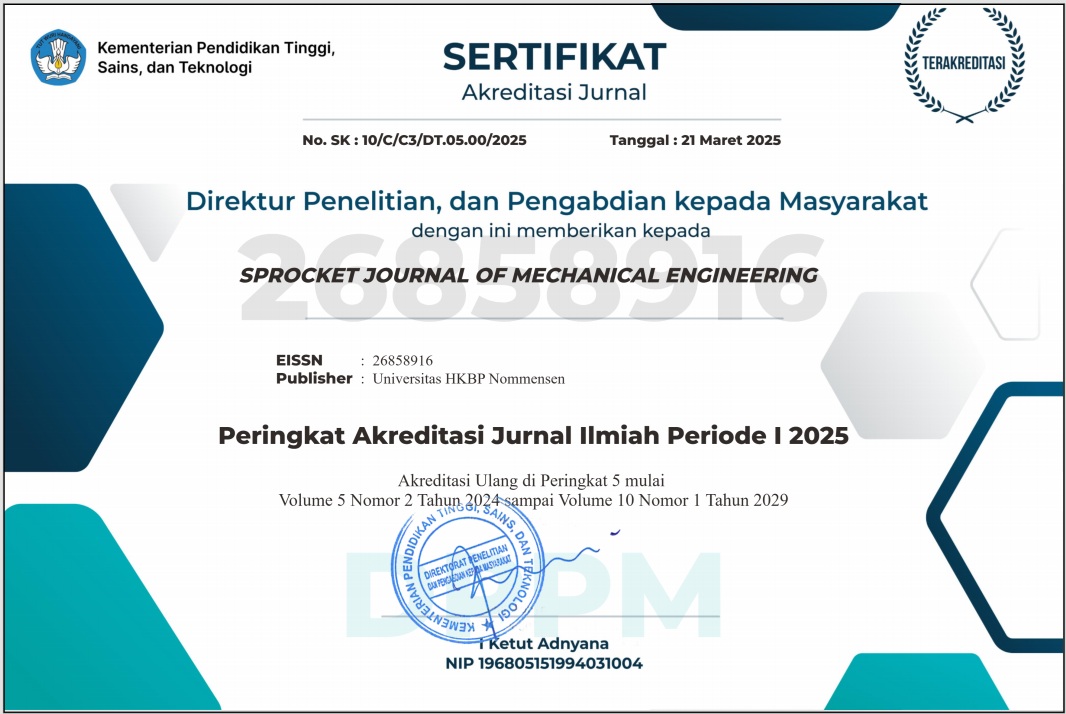Manufaktur Pisau Dan Sistem Pemindah Daya Pada Alat Pemotong Tanaman Tarum (Indigofera)
Abstract
Tarum (Indigofera) farmers, especially those in Subang Regency, West Java Province, still use manual harvesting methods. Seeing these conditions, it is necessary to carry out new innovations in the indigofera plant industry, which is expected to be able to help ease and speed up the harvesting process. The innovation is to make a cutting tool for tarum plants (Indigofera) with an auto cutting system. In the process of selecting tools, materials and machining must be in accordance with the needs, because this will determine the final result of the product. The manufacturing process uses several steps of the work process, namely, measuring, cutting, joining materials and turning. The manufacturing process of tarum cutting tools (Indigofera) with an autocutting system, includes reading the design drawings, making work preparations, identifying tools and materials used, measuring materials, cutting materials, drilling materials, joining by welding, as well as the results of the cutting knife manufacturing process. and power transfer system. With the dimensions of the upper blade 930 mm long, 60 mm wide, and 3 mm high. The lower blade is 1000 mm long, 60 mm wide and 7 mm high. Power transfer system with axle dimensions of 220 mm x 20 mm. The cover plate of the upper and lower crutches is 140 mm x 140 mm, 12 mm thick. Central crutch cover pipe 113 mm x 59 mm. In testing the performance of the Tarum (Indigofera) cutting tool with the autocutting system, the tool was tested in two stages of testing. The results of testing the knife in cutting the leaf stem are functional, but the knife changes shape due to cutting thick stems, and the power transfer system can reduce the 6800 rpm figure from the motor to 4500 rpm to the knife optimally.
References
[2] M. Ariyanti and Y. Asbur, “Tanaman tarum (Indigofera tinctoria Linn.) sebagai penghasil zat pewarna,” Jurnal Hutan Pulau-Pulau Kecil, vol. 2, no. 1, pp. 109–122, 2018.
[3] R. Suhartono and A. Pratomo, “Perancangan Alat Pemotong Tanaman Tarum (Indigofera),” JURNAL KAJIAN TEKNIK MESIN, vol. 7, no. 2, pp. 83–90, 2022.
[4] E. Supriyanto, ““Manufaktur “dalam Dunia Teknik Industri,” Jurnal Industri Elektro dan Penerbangan, vol. 3, no. 3, 2020.
[5] K. G. Swift and J. D. Booker, Manufacturing process selection handbook. Butterworth-Heinemann, 2013.
[6] A. P. Irawan, Perancangan dan Pengembangan Produk Manufaktur. Penerbit Andi, 2017.
[7] H. Mustofa, Gambar Teknik Mesin untuk SMK/MAK Kelas X. Gramedia Widiasarana Indonesia, 2020.
[8] D. H. Sulistyarini, O. Novareza, and Z. Darmawan, Pengantar Proses Manufaktur untuk Teknik Industri. Universitas Brawijaya Press, 2018.
[9] A. Armansyah, H. Saputro, and N. Rohman, “Upaya Meningkatkan Hasil Praktik pada Mata Pelajaran Pemesinan melalui Penggunaan Work Preparation Sheet Siswa Kelas XI TPM 1 SMK Pancasila Surakarta Tahun Pelajaran 2016/2017,” VANOS Journal of Mechanical Engineering Education, vol. 2, no. 1, 2017.
[10] W. P. Syam, “Toleransi dimensi dan geometri-Analisis rantai variasi dalam proses perakitan produk,” 2019.

This work is licensed under a Creative Commons Attribution 4.0 International License.
Penulis yang menerbitkan dengan SPROCKET JOURNAL OF MECHANICAL ENGINEERING menyetujui ketentuan berikut :
- Penulis memegang hak cipta dan memberikan jurnal hak penerbitan pertama dengan karya yang dilisensikan secara bersamaan di bawah Lisensi Internasional Creative Commons Atribusi 4.0 . yang memungkinkan orang lain untuk berbagi karya tersebut dengan pengakuan atas kepengarangan karya dan penerbitan awal dalam jurnal ini.
- Penulis dapat membuat pengaturan kontraktual tambahan yang terpisah untuk distribusi non-eksklusif atas versi jurnal yang diterbitkan dari suatu karya (misalnya, mempostingnya ke repositori institusional atau menerbitkannya dalam sebuah buku), dengan pengakuan atas penerbitan awalnya di jurnal ini.
- Penulis diizinkan dan didorong untuk mengunggah karya mereka secara daring (misalnya, di repositori institusi atau di situs web mereka) sebelum dan selama proses penyerahan, karena hal ini dapat mengarah pada pertukaran yang produktif, serta kutipan yang lebih awal dan lebih banyak dari karya yang diterbitkan (Lihat Pengaruh Akses Terbuka ).






.png)
.png)

